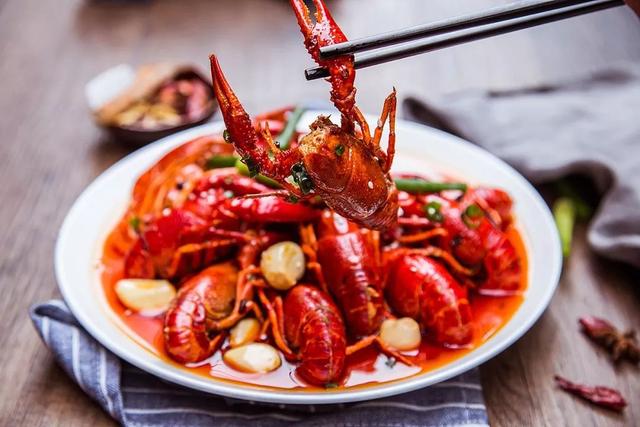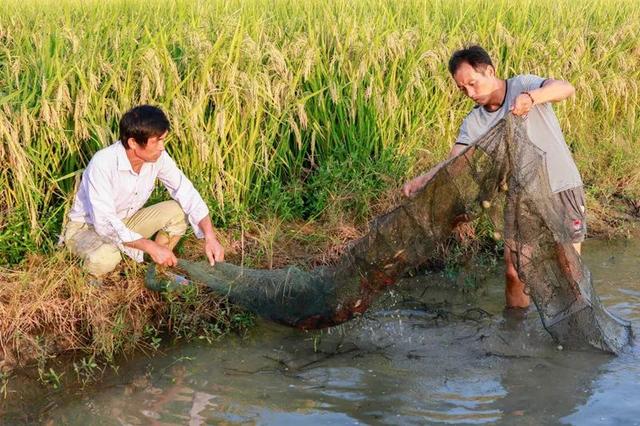近年来,壳多肉少,味美汁香的小龙虾火了。
曾经鲜见于餐桌的它,在不少地方一度只是小孩的玩物,而今,它成了红遍中外的爆款美食。

可你有没有想过,为啥火了的偏偏是它?

在湖北省会武汉和小龙虾主产地潜江,吃“虾”早已成为一股风尚,在茫茫吃货中,我们似乎找到了一些答案。
About 10 plates, dotted with crawfish legs soaked in oil, are spread across a small table. What little space remains is occupied by piles of crawfish shells and two bottles of spirits.
差不多十个盘子拥挤在一张不大的桌子上,零零星星的的小龙虾腿浸在油里,点缀其中。小龙虾壳在剩下的不多的空间里堆成了小山,两瓶白酒立在其间。
This is the scene at a packed crawfish restaurant in Wuhan, capital of Hubei province, where demand for the freshwater crustaceans is running hot.
这一幕出现在武汉一家座无虚席的小龙虾餐厅里,对这一淡水甲壳类动物的需求在这湖北首府火爆异常。
packed:挤满了人的
crustacean:[krʌ'steʃən] 甲壳纲动物
✈ 竟有人“飞的”三千多公里只为小龙虾而来!
Li Fei, his face reddened, waves his oily hands around and says, "My five friends and I have flown all the way from Urumqi (capital of the Xinjiang Uygur autonomous region) for about four hours just to eat crawfish for the next three days."
满脸通红的李飞(音)边摇晃着他那油迹斑斑的手,边说:“我们六个人,从乌鲁木齐坐了四个小时飞机过来,只为一件事:在接下来的三天里吃‘虾’。”
For many, this group's passion for the dish may be extreme. But it gives an insight into just how much Chinese enjoy eating crawfish, which in the past decade has risen to unbelievable heights of popularity.
也许很多人会觉得他们对食物的热情有点太过狂热,但从中我们也可一窥中国人对小龙虾的喜爱。过去这十年,小龙虾达到了难以置信的火爆程度。
小龙虾甚至和啤酒一道成为看世界杯的必备。世界杯开幕当天,从晚9点到12点的短短三个小时的时间里,美团外卖就送出了超过150万只小龙虾。
The species is said to have been brought to China by the Japanese in the 1930s. Decades ago, crawfish were rarely seen on Chinese dining tables.
据说,小龙虾是1930年代由日本人带入中国的。几十年前,中国餐桌上鲜有它们的身影。
This year, however, crawfish have been marketed in increased numbers-even before they mature-to meet demand. The dish has been a must-have for fans watching matches during the World Cup soccer tournament in Russia.
然而,今年小龙虾销量增长迅速,为了满足食客的需求,没等它们生长成熟就要投放市场。在俄罗斯世界杯期间,这一菜肴更是成为球迷们的观赛必备品。
When the World Cup started on June 15, Meituan-Dianping, China's largest on demand online service provider, delivered more than 1.5 million crawfish between 9 pm and midnight across the country.
6月15日,世界杯刚刚拉开帷幕时,美团点评作为中国最大的即时在线服务供应商,从晚上9点到午夜12点在全国范围内累计运送了超过150万小龙虾。
去年,我国小龙虾相关产业产值同比增长83%,达到了2685亿元,而其中以餐饮业为主的第三产业的产值就达到了2000亿元。小龙虾产业仍在快速扩张。
Crawfish-related industries, including farming, processing and catering, saw output rocket by about 83 percent year-on-year to reach 268.5 billion yuan last year. Crawfish catering alone generated about 200 billion yuan.
养殖、加工、餐饮等小龙虾相关产业产值去年增长约83%,达到了2685亿元,其中仅餐饮业一项就创造了2000亿元的产值。
The market continues to expand rapidly.
小龙虾产业的市场仍在迅速扩张。
人口不足百万的潜江,是“虾稻共作”模式的诞生地,如今有15万人从事龙虾相关工作,小龙虾年消费量更是达到了惊人的50万吨。
In the 1990s, Liu Zhuquan, a farmer in Qianjiang, reportedly invented an agricultural method to combine rice planting with crawfish breeding. This has been widely adopted in many areas of China and has helped to greatly increase the supply of crawfish.
在上世纪90年代,潜江市农民刘主权发明了一种将水稻种植与小龙虾养殖结合起来的农作方式。“虾稻共生”模式在中国多地被广泛采用,极大提升了小龙虾的供给量。
Even Liu has been surprised by the popularity of crawfish. "The dish is so popular that many crawfish were put into the market even before they matured this year," said the farmer, who has been in the industry since coming up with the new method.
“虾稻共生”模式创始人刘主权对小龙虾的风靡程度也感到有些吃惊。“小龙虾太受欢迎了,甚至于今年有些小龙虾还没长熟就进入了市场。”刘主权说。
据潜江市政府介绍,刘主权的“虾稻共生”模式如今以应用于该市43000余公顷的稻田。去年,这一行业的产值高达230亿元。
Qianjiang, which has a population of about 1 million, now boasts more than 2,000 crawfish restaurants, which can offer more than 100 different courses of the dish. About 500,000 tons of crawfish are eaten in the city annually, and more than 150,000 people now work in crawfish-related industries.
潜江市约有100万人口,而现今拥有超过2000家小龙虾餐厅,可以提供百余种小龙虾菜肴。在这个城市,每年有50万吨小龙虾被端上餐桌,超过15万人在相关行业工作。
小龙虾为什么火
即便价格一路高涨,围绕着小龙虾的“谣言”满天飞,但吃“虾”之风在中华大地只增未减。相信手机前的你不禁要问了,小龙虾凭借什么征服了众多食客的味蕾?
有人道,小龙虾让“低头族”抬头做人,有人道,小龙虾实现了“人人平等”。
Zhang Denghua, president of Chuxiawang, a crawfish restaurant in Qianjiang, said the dish has gained popularity as it "offers the best platform for people to socialize".
潜江味道工厂楚虾王创始人章登华说,小龙虾之所以流行,是因为其“为人们提供了最佳的社交平台”。
如今,餐桌之上,众食客忙着玩手机,近在咫尺,却相对无言,这般景象早已司空见惯。
If they eat crawfish, however, using their phones becomes difficult, even impossible, as they have to use their hands to pull off the shells, leaving their hands covered in oil.
而吃的如果是小龙虾,玩手机就没那么容易,甚至不太可能,因为众食客们早已因为剥小龙虾而满手是油。
The dish is tasty, but it takes a lot to satisfy diners. So they continue to eat, which also prevents them from holding their phones, Zhang said.
小龙虾好吃,但又吃不饱,所以得一直吃,而且吃这东西,一直握着手机可不行,章登华说。
"Crawfish used to be only a midnight snack, but has become a formal dish for dinner," he said.
“小龙虾之前只是宵夜小吃,如今却一跃成为正餐。”章登华说。
张骏是武汉的一名工程师,从2003年就开始吃小龙虾了。他对于小龙虾的火爆也有自己的看法:因为小龙虾打破了阶层的隔阂。
He said that originally the dish was only sold in small, dingy restaurants but is now served in more upmarket eateries.
他说,起初,小龙虾只在昏暗不洁的小店售卖,现如今已经出现在高档餐馆的菜单上了。
Zhang Jun said crawfish works well in helping people to socialize, but he does not agree that it has gained in popularity because it prevents people from playing with their phones during dinner.
张骏同意吃小龙虾会促进人们的交往,但防止人们在餐桌上玩手机并不是小龙虾愈发流行的原因。
"No matter who you are and what your social status is, you have to pocket your pride when eating crawfish. You have to roll up your sleeves, as the oil will soon cover your hands and even flow to your elbow. From this point of view, it helps bridge the gap between different people," he said.
“无论你是谁,来自哪个社会阶层,要吃小龙虾,就不能‘端着’,都得撸起袖子,因为油不仅会沾满你的手,甚至还会顺着胳膊一路而下,流到胳膊肘。从这一点上来讲,小龙虾能拉近人与人之间的距离。”张骏说。
Zhang Jun said crawfish does not have much meat. It is time-consuming to eat, which makes it a perfect food for people to enjoy together.
张骏说,小龙虾没有什么肉,吃的时候很费时间,正是这一点让其成为人们社交时的绝佳食物。
而无论是谁似乎都在一点上保持了高度的一致,那就是:好吃才是王道!
Zhang Jun said the main reason for the popularity of crawfish is its taste, which appears to be universally accepted by all diners.
张骏说,小龙虾的口味受到了各地食客的青睐,这是其火爆的主要原因。
Li Fei, the man from Urumqi, said: "Instead of beer, we drank spirits. Why? Because beer takes up too much room in the stomach. The crawfish is tasty. We want to save space for it."
不远千里从乌鲁木齐来武汉吃虾的李飞(音)说道:“我们不喝啤酒,只喝白酒,为什么?因为小龙虾好吃,啤酒占肚子,我们要把肚子留给小龙虾。”
诸位看客,对于小龙虾火起来的原因,您又怎么看?欢迎留言讨论!
编辑:左卓
实习生:宋安康
,




















